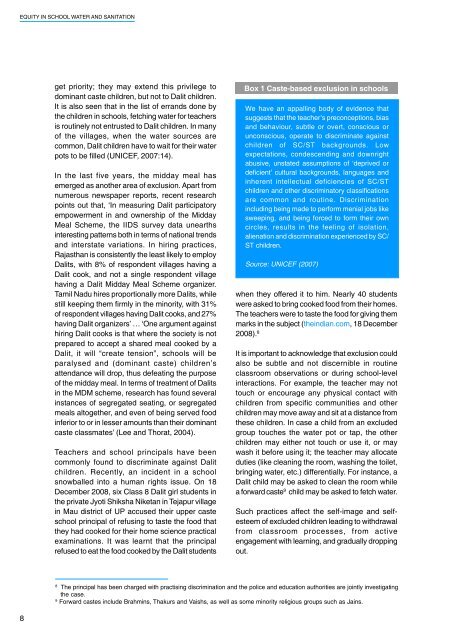Equity in School Water and Sanitation
Equity in School Water and Sanitation
Equity in School Water and Sanitation
Create successful ePaper yourself
Turn your PDF publications into a flip-book with our unique Google optimized e-Paper software.
EQUITY IN SCHOOL WATER AND SANITATIONget priority; they may extend this privilege todom<strong>in</strong>ant caste children, but not to Dalit children.It is also seen that <strong>in</strong> the list of err<strong>and</strong>s done bythe children <strong>in</strong> schools, fetch<strong>in</strong>g water for teachersis rout<strong>in</strong>ely not entrusted to Dalit children. In manyof the villages, when the water sources arecommon, Dalit children have to wait for their waterpots to be filled (UNICEF, 2007:14).In the last five years, the midday meal hasemerged as another area of exclusion. Apart fromnumerous newspaper reports, recent researchpo<strong>in</strong>ts out that, ‘In measur<strong>in</strong>g Dalit participatoryempowerment <strong>in</strong> <strong>and</strong> ownership of the MiddayMeal Scheme, the IIDS survey data unearths<strong>in</strong>terest<strong>in</strong>g patterns both <strong>in</strong> terms of national trends<strong>and</strong> <strong>in</strong>terstate variations. In hir<strong>in</strong>g practices,Rajasthan is consistently the least likely to employDalits, with 8% of respondent villages hav<strong>in</strong>g aDalit cook, <strong>and</strong> not a s<strong>in</strong>gle respondent villagehav<strong>in</strong>g a Dalit Midday Meal Scheme organizer.Tamil Nadu hires proportionally more Dalits, whilestill keep<strong>in</strong>g them firmly <strong>in</strong> the m<strong>in</strong>ority, with 31%of respondent villages hav<strong>in</strong>g Dalit cooks, <strong>and</strong> 27%hav<strong>in</strong>g Dalit organizers’ … ‘One argument aga<strong>in</strong>sthir<strong>in</strong>g Dalit cooks is that where the society is notprepared to accept a shared meal cooked by aDalit, it will “create tension”, schools will beparalysed <strong>and</strong> (dom<strong>in</strong>ant caste) children’sattendance will drop, thus defeat<strong>in</strong>g the purposeof the midday meal. In terms of treatment of Dalits<strong>in</strong> the MDM scheme, research has found several<strong>in</strong>stances of segregated seat<strong>in</strong>g, or segregatedmeals altogether, <strong>and</strong> even of be<strong>in</strong>g served food<strong>in</strong>ferior to or <strong>in</strong> lesser amounts than their dom<strong>in</strong>antcaste classmates’ (Lee <strong>and</strong> Thorat, 2004).Teachers <strong>and</strong> school pr<strong>in</strong>cipals have beencommonly found to discrim<strong>in</strong>ate aga<strong>in</strong>st Dalitchildren. Recently, an <strong>in</strong>cident <strong>in</strong> a schoolsnowballed <strong>in</strong>to a human rights issue. On 18December 2008, six Class 8 Dalit girl students <strong>in</strong>the private Jyoti Shiksha Niketan <strong>in</strong> Tejapur village<strong>in</strong> Mau district of UP accused their upper casteschool pr<strong>in</strong>cipal of refus<strong>in</strong>g to taste the food thatthey had cooked for their home science practicalexam<strong>in</strong>ations. It was learnt that the pr<strong>in</strong>cipalrefused to eat the food cooked by the Dalit studentsBox 1 Caste-based exclusion <strong>in</strong> schoolsWe have an appall<strong>in</strong>g body of evidence thatsuggests that the teacher’s preconceptions, bias<strong>and</strong> behaviour, subtle or overt, conscious orunconscious, operate to discrim<strong>in</strong>ate aga<strong>in</strong>stchildren of SC/ST backgrounds. Lowexpectations, condescend<strong>in</strong>g <strong>and</strong> downrightabusive, unstated assumptions of ‘deprived ordeficient’ cultural backgrounds, languages <strong>and</strong><strong>in</strong>herent <strong>in</strong>tellectual deficiencies of SC/STchildren <strong>and</strong> other discrim<strong>in</strong>atory classificationsare common <strong>and</strong> rout<strong>in</strong>e. Discrim<strong>in</strong>ation<strong>in</strong>clud<strong>in</strong>g be<strong>in</strong>g made to perform menial jobs likesweep<strong>in</strong>g, <strong>and</strong> be<strong>in</strong>g forced to form their owncircles, results <strong>in</strong> the feel<strong>in</strong>g of isolation,alienation <strong>and</strong> discrim<strong>in</strong>ation experienced by SC/ST children.Source: UNICEF (2007)when they offered it to him. Nearly 40 studentswere asked to br<strong>in</strong>g cooked food from their homes.The teachers were to taste the food for giv<strong>in</strong>g themmarks <strong>in</strong> the subject (the<strong>in</strong>dian.com, 18 December2008). 8It is important to acknowledge that exclusion couldalso be subtle <strong>and</strong> not discernible <strong>in</strong> rout<strong>in</strong>eclassroom observations or dur<strong>in</strong>g school-level<strong>in</strong>teractions. For example, the teacher may nottouch or encourage any physical contact withchildren from specific communities <strong>and</strong> otherchildren may move away <strong>and</strong> sit at a distance fromthese children. In case a child from an excludedgroup touches the water pot or tap, the otherchildren may either not touch or use it, or maywash it before us<strong>in</strong>g it; the teacher may allocateduties (like clean<strong>in</strong>g the room, wash<strong>in</strong>g the toilet,br<strong>in</strong>g<strong>in</strong>g water, etc.) differentially. For <strong>in</strong>stance, aDalit child may be asked to clean the room whilea forward caste 9 child may be asked to fetch water.Such practices affect the self-image <strong>and</strong> selfesteemof excluded children lead<strong>in</strong>g to withdrawalfrom classroom processes, from activeengagement with learn<strong>in</strong>g, <strong>and</strong> gradually dropp<strong>in</strong>gout.8The pr<strong>in</strong>cipal has been charged with practis<strong>in</strong>g discrim<strong>in</strong>ation <strong>and</strong> the police <strong>and</strong> education authorities are jo<strong>in</strong>tly <strong>in</strong>vestigat<strong>in</strong>gthe case.9Forward castes <strong>in</strong>clude Brahm<strong>in</strong>s, Thakurs <strong>and</strong> Vaishs, as well as some m<strong>in</strong>ority religious groups such as Ja<strong>in</strong>s.8












